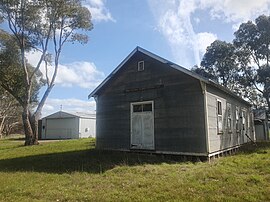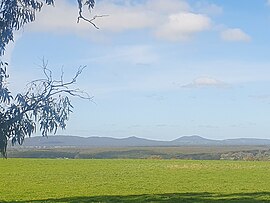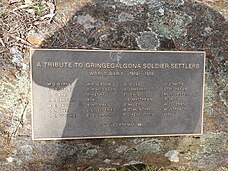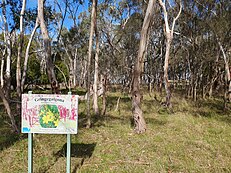| Gringegalgona Victoria | |||||||||||||||
|---|---|---|---|---|---|---|---|---|---|---|---|---|---|---|---|
 Gringegalgona Hall and Fire Shed, 2023 Gringegalgona Hall and Fire Shed, 2023 | |||||||||||||||
 View from Gringegalgona towards Mount Dundas View from Gringegalgona towards Mount Dundas | |||||||||||||||
 | |||||||||||||||
| Coordinates | 37°25′S 141°47′E / 37.417°S 141.783°E / -37.417; 141.783 | ||||||||||||||
| Population | 44 (2021 census) | ||||||||||||||
| Postcode(s) | 3315, 3407 | ||||||||||||||
| Location | |||||||||||||||
| LGA(s) | Shire of Southern Grampians | ||||||||||||||
| State electorate(s) | Lowan | ||||||||||||||
| Federal division(s) | Wannon | ||||||||||||||
| |||||||||||||||
Gringegalgona, also known as Gringe, is a locality in Western Victoria, Australia. At the 2021 Census Gringegalgona had a population of 44.
Etymology
The area is named for the homestead and station, squatted by Simon Cadden in 1843. The name is believed to be indigenous in origin, with locals believing it means "water like urine" or to "micturate on a tussock".
History
The original size of Gringegalgona station was approximately 58,880 acres and could run approximately 16,000 sheep. Simon Cadden was killed by local indigenous people in and was buried in a lone grave on the station. The grave still exists nearby the ruins of Cadden's original homestead. The station was passed on to William Lewis in 1854. In 1860 the station was subdivided and was co-owned by William Lewis and John Lewis until 1861 when Duncan Robertson purchased Gringegalgona. Robertson was from Scotland and spoke Scottish Gaelic as a first language. Robertson built the present homestead in 1873, using sandstone from nearby Mt Melville in the Dundas Ranges.
It was common for kangaroo drives to take place on Gringegalgona. Kangaroos were rounded up into yards and beaten to death.
Sheep on the station were washed in a large dam, known as a sheepwash, prior to shearing. A sawmill was nearby to the sheepwash.
In 1920 Gringegalgona was subdivided as part of the Soldier Settlement scheme for soldiers returning from the First World War. Blocks were subdivided into approximately 900 acre sections, and leased to soldiers on the proviso that they were improved, fenced and cleared appropriately. A monument to the original soldier settlers is on a plaque in Gringegalgona.

In 1925 a soldiers' memorial hall was built in Gringegalgona to honour the fallen in World War One. Built on land donated by soldier settler William Toleman, it was designed by fellow soldier settler Vine Yuill and cost £490 to build. The hall was proposed to be rebuilt in the late 2000s, however some public outcry meant that this did not occur. The hall was re-roofed however the interior was not renovated and the hall is no longer in use.

Gringegalgona State School (no. 4349) was opened near the hall in 1927. It was run part time with Brit Brit State School until 1928, after which it became a full time school. In 1948 the school closed and was moved to Balmoral to become one of the classrooms of Balmoral Consolidated School. Bil-Bil-Wyt SS no. 1936 and Gringe North no. 4234 State Schools were also located in Gringegalgona. Bil-Bil-Wyt closed in 1903 when the five families with the surname Brown who used the school all moved to Coleraine. Gringe North was closed in 1945 and the building was moved approximately five kilometres from its original location.
Gringegalgona once had a tennis club, football club and cricket club, however these have all folded.
Gringe Fire Brigade has been based at Gringegalgona since moving from Brit Brit in 1995.
In January 2022 a bushfire was started in Gringegalgona after a red gum was set alight by lightning. This prompted a major response from aerial firefighting planes, volunteer fire brigades, and private firefighting units. The blaze was extinguished before any infrastructure was destroyed. Some fences were damaged however there was no loss of livestock.
References
- "2021 Gringegalgona, Census All persons QuickStats | Australian Bureau of Statistics". www.abs.gov.au. Retrieved 2023-08-17.
- ^ Victorian historical magazine 1927 Volume: 11 Issue: 44. (1927). Melbourne: Historical Society of Victoria.
- "Claims to Leases of Crown Lands" (PDF). Port Phillip Government Gazette. 21 February 1849.
- ^ "Gringegalgona". vhd.heritagecouncil.vic.gov.au. Retrieved 2023-08-18.
- "Heritage Place – Gringegalgona" (PDF).
- "Public Record Office Victoria Collection | PROV". prov.vic.gov.au. Retrieved 2023-08-18.
- "Gringegalgona Soldier Settlement | Monument Australia". monumentaustralia.org.au. Retrieved 2023-08-18.
- "Gringegalgona Soldiers Memorial Hall | Monument Australia". monumentaustralia.org.au. Retrieved 2023-08-18.
- "Gringegalgona SS 4349, Coleraine, Victoria, Australia". www.swvic.org. Retrieved 2023-08-18.
- Vision and Realisation: a centenary history of state education in Victoria, Vols. 2 & 3, Education Department of Victoria, Melbourne, 1973
- "Bil-bil-wyt SS 1936, Coleraine, Victoria, Australia". www.swvic.org. Retrieved 2023-08-18.
- Coleraine District Cricket Association Premiers 1952.
| Localities in the Shire of Southern Grampians | ||
|---|---|---|
| City |  | |
| Town | ||
| Locality |
| |
| ^ - Territory divided with another LGA | ||